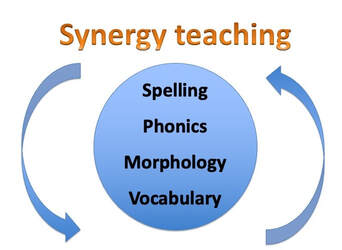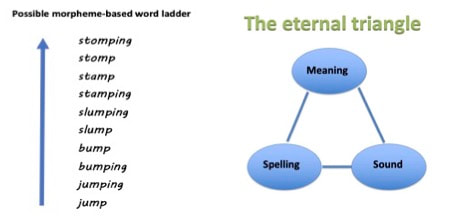|
Sponics and morphabulary – ever heard of them? Microsoft Word certainly hasn’t. As I type the words on my laptop, they appear underlined in jaggedy red. Jaggedy is underlined, too! I love language and so it’s fun for me to create new words by playfully combining elements of spelling & phonics, morphology & vocabulary, and jagged & raggedy. Each of those six words, by the way, is an entry in your brain dictionary. As your eyes scan each word’s letter sequence, your brain recognizes that the sequence is a correct one. In other words, each word is spelled correctly. This recognition of a correct word spelling then triggers word meaning (definition) and sound (pronunciation). On the other hand, my three made up words – sponics, morphabulary, jaggedy – are not entries in your brain dictionary. That’s why when you first encountered them, you probably slowed down to ponder them. I’m using made-up words as an entry to these important points: 1) spelling is critical to the reading process, 2) it pays to teach spelling and phonics together, 3) it also pays to connect morphology and vocabulary, and 4) all manner of reading, writing, and spelling is dependent upon the orthographic processing system. Orthography and More Orthography is the conventional spelling system of a language. It can be thought of as the recordings of correct letter sequences. These sequences, stored in our brain’s neural circuitry as chunks and words, are used for spelling and reading. The two actions of spelling and reading, or encoding and decoding, inform and reinforce one another. Practicing spelling can help us become more fluent readers; conversely, engaging in lots of reading can help us remember the spelling of words. I like to use one term – orthography – when discussing instruction that teaches spelling-phonics because I want to drive home the idea that the two are best understood when presented together. Linnea Ehri famously pointed out that encoding and decoding (spelling and phonics) are “two sides of the same coin.” Vocabulary, which has to do with meaning and may involve the analysis of morphemes (word parts that have meaning), also has connections to encoding and decoding. Thus, I often think of instruction that promotes automatic word recognition in terms of one hyphenated concept: phonics-spelling-morphology-vocabulary. In more playful moments, it’s sponics and morphabulary. Either way, integrated instruction leads to synergy, an effect beyond what is contained in the individual parts. With its roots firmly in phonological awareness and its parts intertwined with language comprehension, phonics-spelling-morphology-vocabulary becomes much less than itself when disassembled into parts that are then taught in isolation. So it makes sense to engage in integrative instruction. Here are two routines that neatly combine spelling and phonics (orthography), as well as sound (phonology) and a bit of vocabulary and morphology (meaning). Hear It, Say It, Write It, Read It Based on the work of Dr. Richard Gentry, this routine is an alternative to a traditional spelling quiz. Start with ten words that contain the patterns you want to teach. For example, let’s say you want to teach ways of spelling the Long O and Long E sound and your lesson is on the positional spellings OA and EA. My routine, which starts with direct and explicit instruction and then moves to repeated guided and independent practice, activates meaning, sound, and spelling (the Eternal Triangle I love to talk about). The routine might sound something like this:
You’ll notice that the routine has the students say the word multiple times (phonology) and gives an opportunity for both spelling and then reading (orthography). Also, the routine does not present the word in a sentence, such as “When he found his wallet was missing, the man let out a load groan.” Rather, it directly and explicitly defines the meaning of the word: “Groan, a deep sound of sadness or pain.” Thus, meaning is directly and explicitly built, just like the spelling of the sound. In the Hear It, Say It, Write It, Read It routine, meaning is rooted in vocabulary. But we can also teach meaning through morphology, as in the word ladder routine below. A morpheme is the smallest unit of meaning in a word. Ant has one morpheme – the word itself, meaning a small, hard-working, colony-based insect. When we add a plural S to make ants, the word now has two morphemes, ant + s. Anthill also has two morphemes or meaning parts: ant + hill. If we add a plural S to make anthills, the word has three meaning parts. Word Ladder for Meaning, Sound, and Spelling This word ladder routine is an example of teaching meaning, sound, and spelling with a special emphasis on morphology. Like Hear It, Say It, Write It, Read It, this routine starts with direct and explicit instruction and then moves to repeated practice that activates meaning, sound, and spelling. Here’s an example of what the routine might sound like in a classroom.
* NOTE: Continue this routine to teach the ED ending. Summary
Both routines activate the Eternal Triangle: meaning, sound, and spelling. Both incorporate Linnea Ehri’s very important observation that decoding and encoding are “two sides of the same coin.” They use the effective instructional practices of direct and explicit instruction and repetition. And both create synergy by incorporating some vocabulary and morphology instruction. Sponics and morpabulary - no matter how you spell it, directly and explicitly teaching students the fundamentals of reading in a synergistic way is effective practice, the kind that helps to prevent reading difficulties from developing. |
Mark WeaklandI am a teacher, literacy consultant, author, musician, nature lover, and life long learner.
|



 RSS Feed
RSS Feed